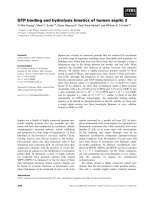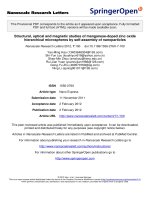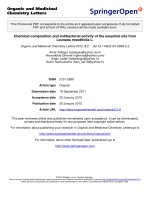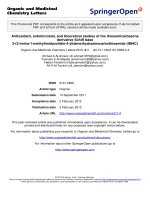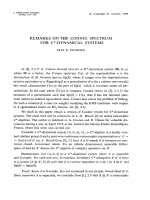Báo cáo toán học: "Controllability Radii and Stabilizability Radii of Time-Invariant Linear Systems" pot
Bạn đang xem bản rút gọn của tài liệu. Xem và tải ngay bản đầy đủ của tài liệu tại đây (92.72 KB, 5 trang )
Vietnam Journal of Mathematics 34:4 (2006) 495–499
Short Communications
Controllability Radii and Stabilizability Radii
of Time-Inv ariant Linear Systems
D. C. Khanh and D. D. X. Thanh
Dept. of Info. Tech. and App. Math., Ton Duc Thang University
98 Ngo Tat To St., Binh Thanh D ist., Ho Chi Minh City, Vietnam
Dedicated to Professor Do Long Van on the occasion of his 65
th
birthday
Received August 15, 2006
2000 Mathematics Subject Classification: 34K06, 93C73, 93D09.
Keywords: Controllability radii, stabilizability radii.
1. Introduction
Consider the system
˙x = Ax + Bu, (1.1)
where A ∈ C
n×m
, B ∈ C
m×n
. Some researchers, such as in [2 - ,4], did research
on the system when both matrices A and B are subjected to perturbation:
˙x =(A +Δ
A
)x +(B +Δ
B
)u. (1.2)
In this paper, we get the formulas of controllability radii in Sec. 2, and stabiliz-
ability radii in Sec. 3 for arbitrary operator norm when both A and B as well as
only A or B is perturbed. This means we also concern the perturbed systems:
˙x =(A +Δ
A
)x + Bu, (1.3)
or
˙x = Ax +(B +Δ
B
)u. (1.4)
The stabilizability radii when the system (1.1) is already stabilized by a given
feedback u = Fx is studied in the end of Sec. 3. And we also answer for the
496 D. C. Khanh and D. D. X. Thanh
question whether t he system (1.1) is also stabilized by perturbed feedback u =
(F +Δ
F
)x for some Δ
F
.
Let M be a matrix in C
k×n
, we denote the smallest singular value of M by
σ
min
(M), the spectrum by σ(M ). The following lemma is the key to obtain the
results of this paper.
Lemma 1.1. Given A ∈ C
m×n
and B ∈ C
k×n
satisfying rank
A
B
= n,we
have
inf
Δ∈C
k×n
Δ :rank
A
B +Δ
<n
=min
x∈KerA
x=1
Bx.
AmatrixK ∈ C
k×n
is said to represent a subspace V of C
k×n
if the following
conditions is satisfied:
•V =Im(K),
•y =1⇔Ky =1.
For example, with spectral norm, K is the matrix the columns of which are the
normal orthogonal basis of V .
Remark 1. For convenience on computing with spectral norm, Lemma 1.1 can
be rewritten as
inf
Δ∈C
k×n
Δ
2
:rank
A
B +Δ
<n
= σ
min
(BK
A
),
where K
A
is the matrix representing KerA
2. Controllability Radii
The controllability radii of system (1.1) with the perturbation on:
• both A and B are defined by
r
AB
=inf
(Δ
A
Δ
B
)
∈C
n×(n+m)
{(Δ
A
Δ
B
): the system (1.2) is uncontrollable},
• only A is defined by
r
A
=inf
Δ
A
∈C
n×n
{Δ
A
: the system (1.3) is uncontrollable},
• only B is defined by
r
B
=inf
Δ
B
∈C
n×m
{Δ
B
: the system (1.4) is uncontrollable}.
Theorem 2.1. The formulas of controllability radii of system (1.1) are
r
AB
=min
λ∈C
min
x=1
(A − λI B)x,
r
A
=min
λ∈C
min
x∈KerB
∗
x=1
(A
∗
−λI)x,
r
B
=min
λ∈C
min
x∈Ker(A
∗
−λI )
x=1
B
∗
x.
Controllability Radii and Stabilizability Radii of Time-Invariant Linear Systems 497
Remark 2. The spectral norm version of Theorem 2.1 is
r
AB
=min
λ∈C
σ
min
(A − λI B),
r
A
=min
λ∈C
σ
min
(A
∗
−λI)K
B
,
r
B
=min
λ∈σ(A)
σ
min
(B
∗
K
λ
),
where K
B
and K
λ
are the matrices representing KerB and Ker(A
∗
− λI), and
the formula of r
AB
is the result obtained in [4].
By the definitions, it is clear that r
AB
≤ min{r
A
,r
B
}, and the strict inequal-
ity may happen as in the case of following system:
˙x =
01
10
x +
10
02
u, (2.1)
Applying Remark 2, we obtain
r
AB
=
√
2,r
A
=+∞,r
B
=
5
2
.
3. StabilizabilityRadii
By the same definitions and proofs as the controllability radii, we get:
Theorem 3.1. The formalas of stabilizability radii of system (1.1) are
r
AB
=min
λ∈C
+
min
x=1
(A −λI B)x,
r
A
=min
λ∈C
+
min
x∈KerB
∗
x=1
(A
∗
−λI)x,
r
B
=min
λ∈C
+
min
x∈Ker(A
∗
−λI )
x=1
B
∗
x,
where
C
+
is the closed right haft complex plane.
Remark 3. The spectral norm version of Theorem 3.1 can be constructed as in
Remark 2 and the inequality r
AB
≤ min{r
A
,r
B
} may also happen strictly.
Now, we assume the system (1.1) is really stabilizable by matrix F ∈ C
m×n
.
That means the system
˙x =(A + BF)x (3.1)
is stable, and we concern following pertubed systems:
˙x =[(A +Δ
A
)+(B +Δ
B
)F ]x, (3.2)
˙x =[(A +Δ
A
)+BF ]x, (3.3)
˙x =[A +(B +Δ
B
)F ]x, (3.4)
˙x =[A + B(F +Δ
F
)]x, (3.5)
498 D. C. Khanh and D. D. X. Thanh
The stabilizability radii of system (3.1) of the feedback matrix F with the
pertubation on
• both A and B are defined by
r
AB
=inf
(Δ
A
Δ
B
)
∈C
n×(n+m)
{(Δ
A
Δ
B
) : the system (3.2) is unstable},
• only A is defined by
r
A
=inf
Δ
A
∈C
n×n
{Δ
A
: the system (3.3) is unstable},
• only B is defined by
r
B
=inf
Δ
B
∈C
n×m
{Δ
B
: the system (3.4) is unstable},
• only F is defined by
r
F
=inf
Δ
F
∈C
m×n
{Δ
F
: the system (3.5) is unstable}.
Theorem 3.2. The formulas of stabilizability radii of system (3.1) of the feed-
back matrix F are
r
AB
=min
λ∈C
+
I
F
[λI −A − BF]
−1
−1
,
r
A
=min
λ∈C
+
(λI − A − BF )
−1
−1
,
r
B
=min
λ∈C
+
F [λI − A − BF ]
−1
−1
,
r
F
=min
λ∈C
+
[λI −A − BF ]
−1
B
−1
.
From the r
F
, it is clear to see that there is so much matrix F making the
system (1.1) stabilizable. And a open question appear: “Which F makes r
AB
,
r
A
,orr
B
maximum?”. For apart result of this question, see [5].
Remark 4. The spectral norm vestion of Theorem 3.2 is
r
AB
=min
λ∈C
+
σ
min
I
F
[λI −A − BF]
−1
,
r
A
=min
λ∈C
+
σ
min
(λI −A −BF )
−1
,
r
B
=min
λ∈C
+
σ
min
F [λI −A − BF ]
−1
,
r
F
=min
λ∈C
+
σ
min
[λI − A − BF]
−1
B
.
The inequality r
AB
≤ min{r
A
,r
B
} may happen strictly as in the case of
following system:
˙x =
10
00
x +
10
02
u. (3.6)
It easy to see that the system (3.6) is not stable, but stabilized by F = Id
2
.
Applying Remark 4 we obtain
Controllability Radii and Stabilizability Radii of Time-Invariant Linear Systems 499
r
AB
=
√
2,r
A
=2,r
B
=2,r
F
=1.
References
1. John S. Bay, Fundamentals of Linear State Space System, McGraw-Hill, 1998.
2. D. Boley, A perturbation result for linear control problems, SIAM J. Algebraic
Discrete Methods 6 (1985) 66–72.
3. D. Boley and Lu Wu-Sheng, Measuring how far a con trollable system is from an
uncontrollable one, IEEE Trans. Automat. Contro l. 31 (1986) 249–251.
4. Rikus Eising, Between controllable and uncontrollable, System
& Control Letters
4 (1984) 263–264.
5. N. K. Son and N. D. Huy, Maximizing the stability radius of discrete-time linear
positive system by linear feedbacks, Vietnam J. Math. 33 (2005) 161–172
